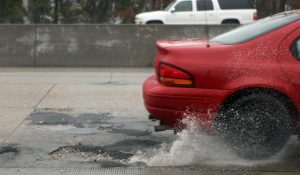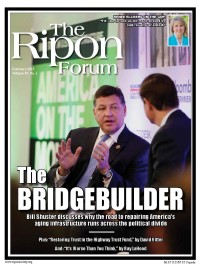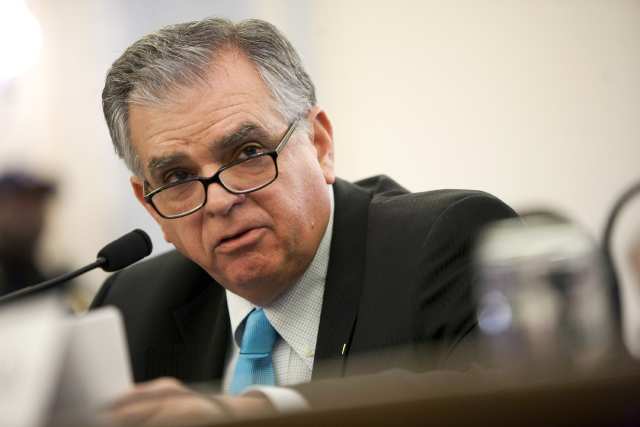America’s transportation infrastructure is falling apart, and we as a nation are falling behind. You know it, and your friends and neighbors do, too, because we experience the potholes and congestion daily. Yet somehow, with every possible indicator pointing toward the need for increased investment in our crumbling roads, bridges and transit systems, policymakers at all levels of government have been sitting on the sidelines.
During my time as Secretary of Transportation, I traveled around the United States meeting with local leaders and citizens who were concerned with the state of the roads in their neighborhoods, and the bridges they crossed every day getting to work. I met airline pilots and business commuters frustrated with the outdated air traffic control systems that led to delays on the tarmac and travel headaches. I met seaport workers concerned that our outdated ports would not be able to accommodate the new post-Panamax vessels that will become the norm once the newly widened Panama Canal opens.
I know the deplorable state of our roads and bridges is not new news, but I am here to tell you: it’s worse than you think. In a recent 60 Minutes segment, my fellow Building America’s Future co-chair former Pennsylvania Governor Ed Rendell and I helped to take an in-depth look at the dismal state of many of America’s most-traveled bridges. Here’s just one disturbing statistic: twenty five percent of the bridges crossed by Americans on a daily basis are either “structurally deficient” or do not have enough capacity for current traffic levels. And as tens of millions of Americans travel over a bridge each and every day, people are rightly concerned about their safety. In this case, the cost of inaction is high.
Because 32 percent of major roads are in poor or mediocre condition, taxpayers are paying on average $444 each year in additional vehicle repairs and operating costs.
The neglect of our roads has led to growing congestion and roads that are not properly maintained. And this is costing taxpayers money.
Because 32 percent of major roads are in poor or mediocre condition, taxpayers are paying on average $444 each year in additional vehicle repairs and operating costs.
And because 44 percent of America’s major urban highways are congested, drivers are paying $121 billion in wasted time and fuel. That amounts to $818 per commuter each year.

According to the American Society of Civil Engineers, the U.S. needs roughly $3.6 trillion in total investment by the year 2020 just to get our systems back to “adequate” status. It’s a hefty price tag, but it’s one we can no longer afford to put off each year.
While federal investment in our transportation network has not kept pace with needs, many states and cities are struggling with their own funding challenges. But instead of waiting for policymakers in Washington to wake up, they have been taking matters into their own hands. Over the past two years, several governors in red states and in blue states have either proposed or signed into law measures to increase revenue for transportation. And voters are willing to do the same if the case is made that increased revenue will go directly to specific projects. The success rate of local ballot initiatives seeking to raise revenue has been impressive. In fact, in November 2014, 72 percent of such initiatives were approved.
And because 44 percent of America’s major urban highways are congested, drivers are paying $121 billion in wasted time and fuel.
It is encouraging to see such actions at the state and local levels, but we must not lose sight of the clear and abiding federal role in setting and funding the nation’s transportation policy. Without an overriding national vision and network, America’s transportation system would resemble a patchwork of disconnected roads and rails, and goods movement would be greatly hindered, all while costing businesses and consumers billions of dollars.
America’s interstate highway system was built because we had a national Highway Trust Fund that was funded directly by the users of the roads through the 18.4 cent per gallon fuel tax. However, due to greater fuel efficiency and more people choosing to drive hybrid vehicles, cars are using less gasoline, and less revenue is flowing to the Highway Trust Fund. And because it has not increased since 1993, this user fee has not kept pace with inflation. Consequently the funding challenges facing our transportation system continue to worsen.
This has been a bipartisan failure, and both Democrats and Republicans must take the blame for not investing in our nation’s infrastructure. There are no Republican bridges or Democratic highways, yet lawmakers from both sides of the aisle continue kicking the can down the road and waiting for disaster to strike.
As gas prices continue to slide, now is the time for action. We must raise the federal user fee and index it to inflation. We need to do it now to address the crisis we’re in and to prevent more problems in the future. These investments will help put our friends and neighbors to work, and put America back on track. Several lawmakers from both parties have voiced support for modernizing the user fee, while others have been hesitant. But we don’t have time to keep debating this or hoping that pennies will fall from heaven to fill in our potholes: we know how to fix it, and how much money it will take. The only piece missing is the political will.
I believe that men and women of good will from both ends of Pennsylvania Avenue can and will find a way to make the tough decisions and to do the right thing to move America forward.
The revenue has to come from somewhere, and the federal user fee makes the most sense.
Ray LaHood is the former U.S. Secretary of Transportation and current co-chair of Building America’s Future, a bipartisan coalition of elected officials dedicated to bringing about a new era of U.S. investment in infrastructure that enhances our nation’s prosperity and quality of life. He is also a senior advisor in the Washington office of DLA Piper LLP.





